THE ITALIAN SCHOOL OF BAROQUE GUITAR
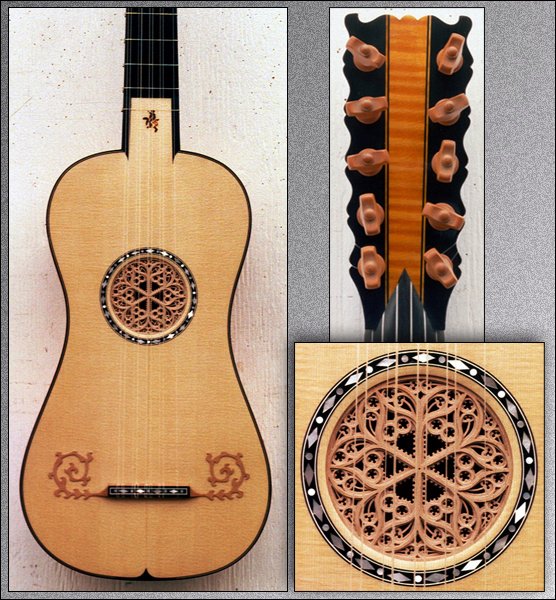
After Antonio Stradivari, Cremona 1700 (Shrine to Music Collection, USA)
From the court of the Archduke Albert, the Hapsburg ruler of the Spanish Netherlands, we find the first important composer of the XVII c. Giovanni Paolo Foscarini (before 1629-1649 Italy), who worked as a guitarist, lutenist, theorbist in his native Italy, and in Brussels. Little is known of his biography except information gathered from his guitar books. He worked at the court of Albert whcih was filled with important artists such as the painter Rubens, and when the king died in 1621, Foscarini's life changed dramatically and we loose track of the composer. His books include: "Intavolature di chitarra spagnola, libro secondo"(1629), his first book is lost to us. He was a member of the 'Academia die Caliginosi' where he adopted the name 'Il Furioso', used in the title pages of his books. Around (1629) Foscarini publised his Primo Secondo and Terzo Libro, important books that use alfabeto but employs the pizzacato style notated in five-line Italian tablature. This was the first system that combined punteado and rasgueado notation, joining two styles that had previously been distinct from each other.
The dots beside the numbers represent the four left hand fingers .
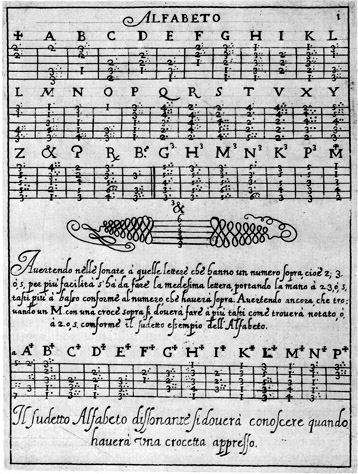
Foscarini Tablature c.1632
Aria Di Firenze by Giovanni Paolo Foscarini- Kapsberger Ensemble
 |
|
Giovanni Paolo Foscarini used the Altered Alfabeto or mixed tablatures, incorporating appogiaturas and fluid passing tones into the chord progressions- by moving fingerings in the first two courses of the guitar. The new additions to the Alfabeto System, new symbols imbeded with dissonances, where labeled lettere tagliate, or lettere false, alfabeto falso o alfabeto dissonante. The Alfabeto is a result of notating a simple musical style of strumming chords on the baroque guitar. These demanded such grace, no former guitar style had articulated such possibilites to what was labled "la seconda prattica". The refined interplay of strummed and plucked styles found in Foscarini's fifth book served as impetus for Francesco Corbetta's transition to mixed style tablature in his Varrii, capricci per la ghitarra spagnola (Milan 1643). In his Guitarre royalle he explains the proper execution of ornaments (in Fench and Italian) covering the trill (tremblement or tremolo), the appogiatura (cheute or abelimento), slur (roullement or stascio), mordent (martellement or rebatimento), vibrato (flettement or tremolo sforzato), cadence figures (cadenses or cadenze) and the sustaining pitch (tenue or tenute). Franceso Corbetta took the guitar to the pinnacle of vituosity, promoting the guitar throughout Europe as a serious instrument worthy of study. He brought together the strummed techniques of the early guitar (rich in harmony) and used them with the single melodic notes and counterpoint from the lutenist's world, synthesizing two separate musical traditions, those of the lute and the guitar. These elements first distilled by Foscarini and Corbetta, were perfected by Sanz, Murcia, Le Cock, Campion, de Visse, Roncalli and Bartolli. |
Folias by Francesco Corbetta- Sonatte al Pizzico
Web Source: Baroque Guitar for the Modern Performer: A Practical Compromise by By Don Rowe and Richard d’A Jensen. Guitar Review, #49, Fall 1981
Watteau steel engraving (1880) "L'Amour au Theatre Italien Masquerades"
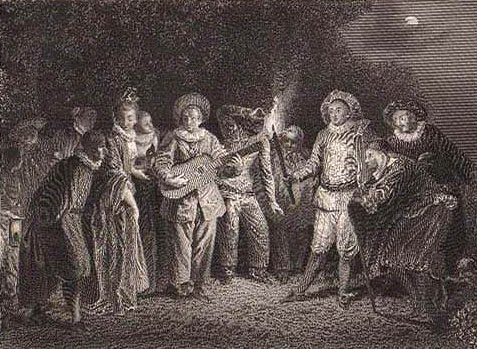
|
Antonio Stradavari (1644-1737) is the most celebrated luthier of
his time. Mostly known for his violins, he also made lutes, mandolas, mandolins,
guitars and harps. Very few of his baroque guitars have survived, the best
known one is in the Hill collection at the Ashmolean Musem in Oxford dated
1688. 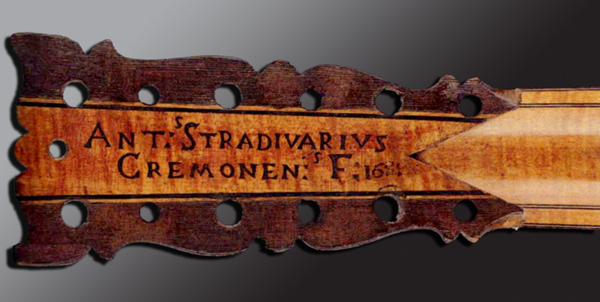
Antonio Stradavaris and baroque guitar making" by Stewart Pollens in The Cambridge Companion to the Guitar
Edited by Victor Anand Coehlo http://www.usd.edu/smm/PluckedStrings/Guitars/Stradivari/StradGuitar.html
Giovanni Battista Granata c.(1620-1680) published seven books of guitar music in Bologna. Capricci armonici sopra la chittariglia spagnuola
(1646)
Nuove suonate di chittariglia spagnuola c.(1650)
Nuova scelta di capricci armonic...opera terza (1655)
Soavi Concenti di sonate musicali..opera quarta (1659)
Novi capricci armonici...opera quinta
(1674)
Novi soavi concenti...opera sesta
(1680)
Armoniosi toni di varie sonate....opera settima (1684)
Granata was a surgeon, as stated in his 1655 book, and a student of Corbetta. His pieces are all dedicated to members of the nobility in the court of Mantua, Florence and Babaria.
His fourth book contains fine original solo music for
baroque guitar, some rare solo music for the theorboed-guitar or chitarrone,
an exquisite sonata for guitar,violin and continuo, and instructions
for playing guitar continuo.
When his music is
played on the modern guitar the fifth string is replaced by one
tuned an octave higher,a modern guitar second string should be
used.
Sonata Di Chitarra, E violino, Con Basso Continuo By Granata Sonate al Pizzico
Theorboed- guitar was used by guitarists who strung and tuned the fingerboard courses like a guitar, and who would be used to reading from the bass clef, so that they could realise a figured bass part and play continuo, rather than learn the completely different archlute tuning. The player's left hand almost exactly corresponds to chord 'L' in the alfabeto system (L corresponds to a difficult fingering for a C minor chord)
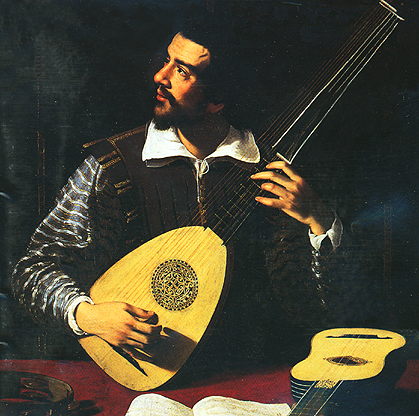
Suonatore di Liuto, by Antiveduto Grammatica, 1571-1626 Galleria Sabauda, Turin
Prelude from Suite in G major for two Theorbos by Robert de Visée

There are several references in surviving books of guitar music to theorboed guitars and guitars fitted with diapasons (although no instruments have survived from this period with seven-or even nine - diapasons):
Giovanni Battista Granata's book Soavi concerti di sonate musicali per chitarra spagnuola, 1659 contains five pieces for chitarra Atiorbata which require five fingerboard courses and seven diapasons, starting at G and going down to low AA.
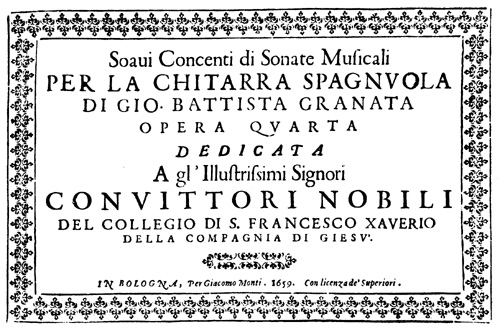 |
 |
© 2006 Patricia A. Dixon